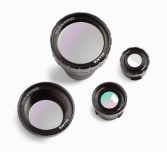Look beyond the Pixel with Fluke
Follow articleHow do you feel about this article? Help us to provide better content for you.
Thank you! Your feedback has been received.
There was a problem submitting your feedback, please try again later.
What do you think of this article?
Have you ever wondered where you start with thermal cameras? Is the first thing you think about is the pixel count as with a normal camera? But when you look beyond the pixel you’ll see the difference, as pixels are only part of the overall equation that determines the infrared image quality.
IMAGE QUALITY = Focus + Optics + Spatial Resolution
Focus
Getting in-focus can be very frustrating with a manual or autofocus systems, as the image being viewed may have multiple targets at different distances, so focusing may not be on the desired target (for example inspecting through a chain linked fence) and this can impact the measured temperature giving an inaccurate reading, this is where Fluke’s LaserSharp® auto focus makes the advantage, using a built-in laser distance meter which can pinpoint the target and enables the camera to capture a precisely focused, high quality image with the distance recorded in your image, as shown in the example below:
Optics
Thermal energy being picked up by the camera’s detector may be affected by the optics being used within the camera, as the material within the lens can impact the transmission of the energy. Fluke’s optics use 100% diamond-turned germanium lenses, which are covered with a specialty coating, making them the most efficient material to transmit energy to the detector and so producing high quality infrared images.
Detector Resolution (Pixels)
As with a standard camera, the more detailed image you need then the higher number of pixels are required in the detector, this is really important when inspecting a target from a distance or when the target is small, as each pixel detects the apparent temperature measurement on that part of the target, so the greater number of pixels, then a more detailed temperature map of the target can be obtained.
Field of View (FOV)
Within a thermal imaging camera the FOV is as important as the detectors resolution for determining the image quality, as it defines the area the thermal imager can see at any one moment in time and is the combination of sensor size, lens and distance to the target. So a camera with a wide FOV will display a large area, which could be an issue if viewing an object from a distance as this would potentially display more than the target area you are inspecting (think of a person in a landscape photo, where only the person is of interest) and as each pixel is a temperature measurement, the target being inspected will be less detailed.
Spatial Resolution (Pixels + Field of view)
Spatial resolution is one of the best kept secrets to image quality, as generally a camera with a higher number of pixels or a narrow field of view will have better spatial resolution.
Spatial resolution is measured in mRads, where the smaller the number will give a more detailed image. Fluke infrared cameras with standard lenses have a range from 0.6mRad (best) to 7.8mRad, whereas many competitive models range up to 10.3mRad.
The example below illustrates spatial resolution - both images were taken with the same number of pixels and from the same distance from the target motor, but the first image has a narrower field of view:
Fluke Professional Series
The latest Fluke Professional Series (PRO) offers superior image quality and ensure images are 100% focused on every object whether it’s near or far and are ideal for professional thermographers and maintenance managers:
- Increased sensitivity to visualize temperature differences
- MultiSharp™ Focus delivers automatically focused images throughout your field of view
- LaserSharp® Auto Focus calculates distance to your designated target with pinpoint accuracy
- Fluke Connect compatible – save time by wirelessly sync images directly from your camera to you PC or smartphone, so giving access to the results to the office or off-site location.
- Easier to visualize and diagnose issues – sharper onscreen images with visual colour differentiation.
- Intuitive visual interface
- Get 4x the pixel data with SuperResolution
- Extend functionality of camera with optional telephoto lenses
- Fluke Ti401 PRO (186-4696)
- Fluke Ti480 PRO (171-6857)








Comments